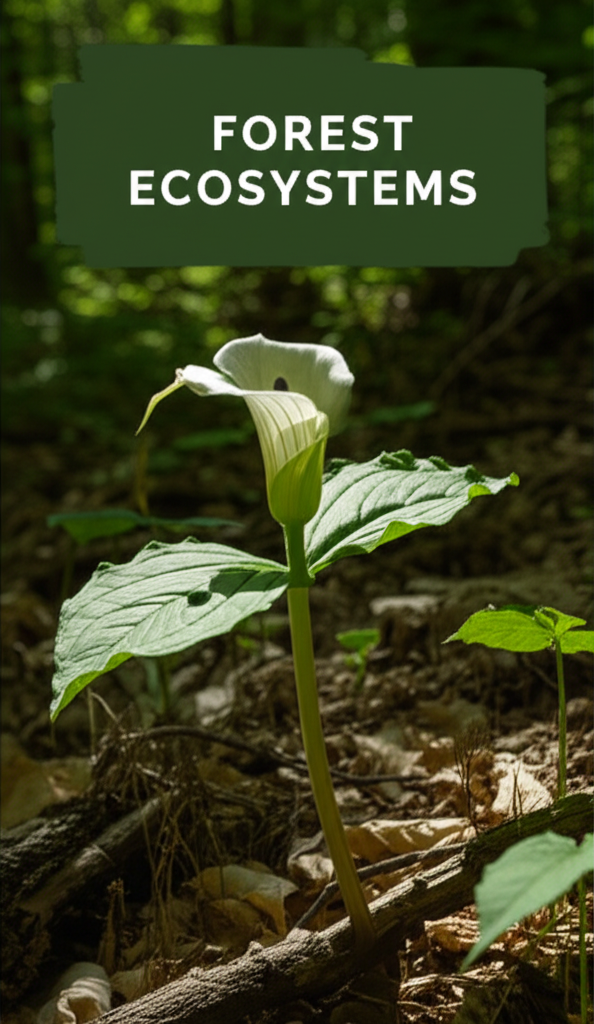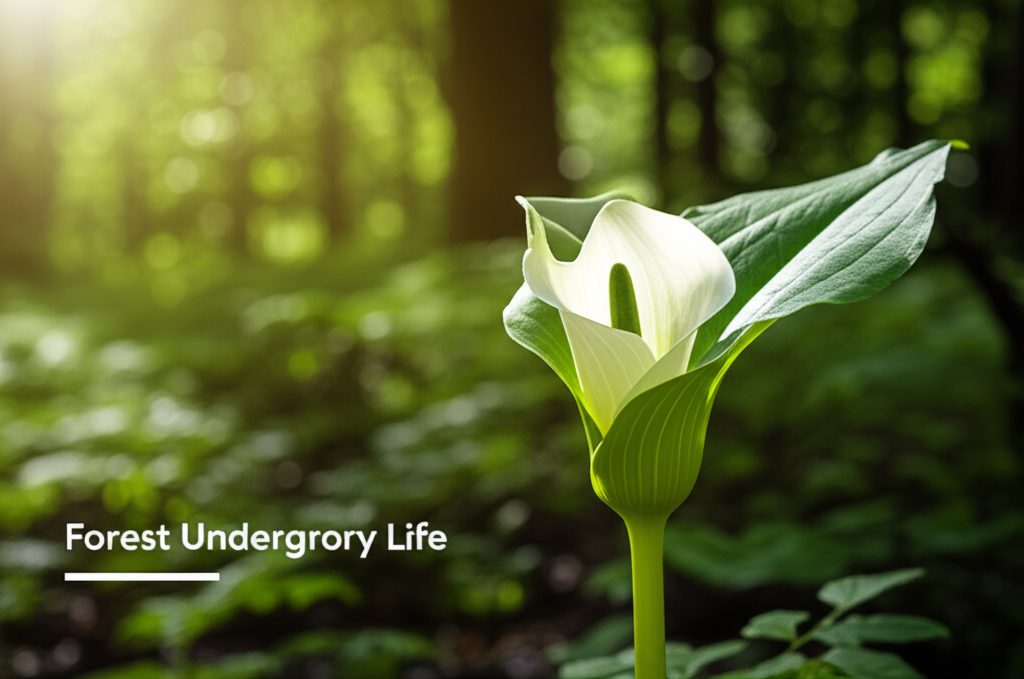Introduction: Unveiling the Mysteries of Jack-in-the-Pulpit
Jack-in-the-Pulpit (Arisaema triphyllum) is a captivating and ecologically significant perennial wildflower that graces the shaded understory of eastern North American forests. Its common name, derived from its distinctive hooded spathe that encloses a club-like spadix, evokes an image of a preacher in a pulpit, a fitting description for this unique botanical marvel. Far from being just a visually striking plant, Jack-in-the-Pulpit plays a crucial role in the intricate web of forest ecosystems, supporting a diverse array of fauna and contributing to the health and resilience of its woodland habitat. This article delves into the fascinating biology, ecological interactions, and conservation importance of this enigmatic woodland dweller.
Botanical Characteristics and Life Cycle

The visual distinctiveness of Jack-in-the-Pulpit begins with its unusual floral structure. The plant typically produces one or two trifoliate leaves, meaning each leaf is divided into three leaflets. These leaves emerge from a subterranean corm, the plant’s energy storage organ, which is essential for its survival through unfavorable conditions. The true marvel, however, lies in the inflorescence. The spathe, the hooded leaf-like structure, can vary in color from green to deep purple-brown, offering both protection and a subtle attractant to pollinators. Inside the spathe, the spadix, a fleshy spike, is covered in tiny, inconspicuous flowers.
The reproductive strategy of Jack-in-the-Pulpit is as fascinating as its appearance. The plant is monoecious, meaning individual plants bear both male and female flowers. However, the sex of the plant can change over its lifetime. Young plants are typically male, transitioning to female as they mature and accumulate sufficient resources to produce seeds. This sequential hermaphroditism is a clever adaptation, ensuring reproductive success by prioritizing seed production in the most robust individuals.
Pollination is a delicate dance with tiny insects, primarily flies and beetles, which are lured into the spathe’s interior by the plant’s subtle scent and the promise of a safe haven. Once inside, they are trapped by downward-pointing hairs (or “staminodes”) within the spathe tube, forcing them to navigate the flowers before escaping. This confinement allows for efficient pollen transfer. After successful pollination, the spathe wilts, and the spadix develops into a cluster of bright red or orange berries, a vital food source for many forest animals.
Key Facts about Jack-in-the-Pulpit
| Feature | Description |
| :————— | :————————————————– |
| Scientific Name | Arisaema triphyllum |
| Common Names | Jack-in-the-Pulpit, Indian Turnip, Devil’s Ear |
| Habitat | Moist, shaded deciduous forests, swamps, ravines |
| Bloom Time | Spring (April to June) |
| Height | 1-3 feet (30-90 cm) |
| Leaf Structure | Trifoliate (three leaflets per leaf) |
| Flower Structure | Spathe (hooded bract) enclosing a Spadix (central spike) |
| Fruit | Cluster of bright red/orange berries |
| Toxicity | Contains calcium oxalate crystals, irritating if ingested raw |
| Lifespan | Perennial, can live for many years |
| Sex Change | Sequential hermaphroditism (male to female) |
Ecological Role in Forest Ecosystems
Jack-in-the-Pulpit is far more than just a botanical curiosity; it is an integral component of the forest floor ecosystem, influencing and being influenced by a multitude of other organisms. Its presence indicates healthy, moist woodland conditions, and its interactions with its environment highlight the interconnectedness of nature.
Food Source for Wildlife
The bright red berries of Jack-in-the-Pulpit are a highly sought-after food source for a variety of forest dwellers. Birds, such as thrushes, woodpeckers, and finches, are known to consume the berries, aiding in seed dispersal. Small mammals, including chipmunks, squirrels, and voles, also feast on these nutritious fruits. The leaves and stems can be browsed by deer and rabbits, though the presence of calcium oxalate crystals makes the raw plant parts unpalatable and irritating if consumed in large quantities.
Pollinator Attraction
As mentioned earlier, the unique floral structure of Jack-in-the-Pulpit is specifically adapted to attract and trap small flying insects for pollination. These pollinators, primarily gnats and midges, are essential for the plant’s reproduction. In turn, the abundant flowering of Jack-in-the-Pulpit in the spring provides an early season nectar and pollen source for these insects, contributing to their population dynamics.
Habitat and Shelter
The dense foliage of Jack-in-the-Pulpit provides a microhabitat for various invertebrates, including insects and spiders. The cool, damp environment beneath its leaves can offer refuge from predators and harsh environmental conditions. Its presence also contributes to the overall biodiversity of the forest understory, creating a more complex and resilient ecosystem.
Indicator Species
Jack-in-the-Pulpit thrives in specific conditions: rich, moist soil, partial to full shade, and protection from strong winds. Its presence and abundance can serve as an indicator of a healthy, undisturbed forest ecosystem. A decline in Jack-in-the-Pulpit populations can signal environmental changes, such as soil degradation, increased pollution, or altered light levels due to forest thinning or clear-cutting.
Threats and Conservation Challenges
Despite its ecological importance, Jack-in-the-Pulpit faces several threats that impact its populations in natural habitats. Understanding these challenges is crucial for effective conservation efforts.
Habitat Loss and Degradation
The most significant threat to Jack-in-the-Pulpit is the ongoing destruction and fragmentation of its forest habitat due to development, agriculture, and logging. The loss of mature forests directly impacts the shaded, moist conditions necessary for its survival. Even in remaining forests, human activities like trail building, excessive foot traffic, and the introduction of invasive species can degrade the understory environment, making it less hospitable for this sensitive plant.
Invasive Species
Invasive plants, such as garlic mustard (Alliaria petiolata) and multiflora rose (Rosa multiflora), can outcompete native wildflowers like Jack-in-the-Pulpit for light, water, and nutrients. These aggressive invasives often form dense monocultures that smother the forest floor, displacing native flora and altering the ecological balance.
Overcollection
While not as prevalent as with some other wild plants, the unique appearance of Jack-in-the-Pulpit can unfortunately lead to overcollection by individuals seeking to transplant it into their gardens or use it for decorative purposes. Sustainable harvesting practices, if any, are essential, and it is generally recommended to admire and appreciate wild populations in their natural settings.
Climate Change
Shifting climate patterns, including altered precipitation regimes and increased temperatures, can also pose a threat. Changes in soil moisture and the timing of seasonal events could disrupt the delicate life cycle of Jack-in-the-Pulpit and the species that depend on it.
Conservation Strategies and Best Practices
Protecting Jack-in-the-Pulpit requires a multifaceted approach that addresses the threats it faces and promotes its long-term survival.
Habitat Preservation and Restoration
The most effective conservation strategy is the protection of existing healthy forest ecosystems. This includes preserving large tracts of mature forest and implementing sustainable forestry practices that maintain a diverse understory. For degraded areas, habitat restoration projects that focus on removing invasive species and re-establishing native plant communities can help create suitable conditions for Jack-in-the-Pulpit to recolonize.
Invasive Species Management
Active management of invasive plants is critical. This can involve manual removal, targeted herbicide application (used cautiously and responsibly), and promoting the growth of native plants to resist invasion. Education campaigns for landowners and park visitors about identifying and controlling common invasive species are also vital.
Public Education and Awareness
Raising public awareness about the ecological importance and vulnerability of Jack-in-the-Pulpit can foster a sense of stewardship. Educating people about the plant’s unique biology, its role in the ecosystem, and the impact of overcollection can encourage responsible behavior in natural areas.
Sustainable Gardening Practices
For those who wish to cultivate Jack-in-the-Pulpit, it is crucial to source plants from reputable nurseries that propagate them ethically, rather than digging them from wild populations. Native plant gardening that prioritizes indigenous species and avoids invasive cultivars also contributes to broader ecological health.
Pros and Cons of Jack-in-the-Pulpit in Forest Ecosystems
Jack-in-the-Pulpit, like many species, brings both benefits and challenges to its ecosystem. Understanding these nuances provides a more complete picture of its ecological role.
Pros and Cons Comparison
| Aspect | Pros | Cons |
| :———————————– | :——————————————————————————————————— | :——————————————————————————————————————————————————————————————————————————————————————————————— |
| Ecological Contribution | Provides food for wildlife (berries), attracts specific pollinators, indicates healthy forest conditions. | Can be a minor food source for deer/rabbits, leading to overgrazing in some areas, potentially impacting plant regeneration if populations are already stressed. |
| Reproductive Strategy | Sequential hermaphroditism maximizes reproductive success and resource allocation. | Dependence on specific pollinators and a narrow range of habitat conditions makes it vulnerable to environmental changes and pollinator declines. |
| Human Interaction | Visually striking, often admired by hikers and nature enthusiasts, educational opportunities. | Susceptible to overcollection from the wild, can be difficult to cultivate successfully without replicating specific soil and light conditions, presence of calcium oxalate crystals makes it unpalatable and requires careful preparation if historically used as a food source (e.g., Indian Turnip). |
| Understory Dynamics | Contributes to the diversity of the forest floor. | Can be outcompeted by aggressive invasive species if forest health is compromised. |
The Future of Jack-in-the-Pulpit
The future of Jack-in-the-Pulpit is intrinsically linked to the health of its forest habitat. As human pressures on natural landscapes continue, proactive conservation efforts are paramount. By understanding and appreciating the intricate role this fascinating plant plays, we can work towards ensuring its continued presence in the dappled sunlight of our woodlands for generations to come. Its enigmatic beauty and vital ecological contributions make it a symbol of the wild, untamed spirit of the forest, a spirit we must strive to protect.
html
<h2>Jack-in-the-Pulpit in Forest Ecosystems: Key Facts/Comparison</h2>
<table>
<thead>
<tr>
<th>Feature</th>
<th>Jack-in-the-Pulpit (Arisaema triphyllum)</th>
<th>Other Understory Plants (Examples)</th>
</tr>
</thead>
<tbody>
<tr>
<td>Sunlight Preference</td>
<td>Shade to partial shade</td>
<td>Varies widely (e.g., ferns prefer shade, some wildflowers tolerate sun)</td>
</tr>
<tr>
<td>Soil Preference</td>
<td>Rich, moist, well-drained soil, often humus-rich</td>
<td>Varies widely (e.g., sandy, clay, acidic, alkaline)</td>
</tr>
<tr>
<td>Pollination</td>
<td>Flies (attracted by scent and color)</td>
<td>Insects (bees, butterflies), wind, self-pollination</td>
</tr>
<tr>
<td>Seed Dispersal</td>
<td>Birds (eat the berries)</td>
<td>Wind, animals, water, gravity</td>
</tr>
<tr>
<td>Seasonal Presence</td>
<td>Emerges in spring, flowers in late spring/early summer, develops berries in late summer/fall</td>
<td>Varies by species; some are evergreen, others ephemeral</td>
</tr>
<tr>
<td>Ecological Role</td>
<td>Provides food for wildlife (berries), habitat for insects, part of the forest understory plant community</td>
<td>Provides food, habitat, nutrient cycling, soil stabilization</td>
</tr>
<tr>
<td>Unique Characteristic</td>
<td>The "spathe" (modified leaf) forms a hood over the "spadix" (flower spike)</td>
<td>Varied; unique leaf structures, flower shapes, growth habits</td>
</tr>
</tbody>
</table>
<h2>Jack-in-the-Pulpit in Forest Ecosystems: Steps/Pros-Cons</h2>
<table>
<thead>
<tr>
<th>Aspect</th>
<th>Description/Action</th>
<th>Pros</th>
<th>Cons</th>
</tr>
</thead>
<tbody>
<tr>
<td rowspan="2">Establishment</td>
<td>Planting seeds or corms in suitable forest habitat</td>
<td>Contributes to biodiversity, supports native flora</td>
<td>Slow to establish, requires specific conditions, susceptible to disturbance</td>
</tr>
<tr>
<td>Natural regeneration via seed dispersal</td>
<td>Self-sustaining population growth, adaptation to local conditions</td>
<td>Relies on animal vectors, can be outcompeted by invasive species</td>
</tr>
<tr>
<td rowspan="2">Interaction with Wildlife</td>
<td>Provides food (berries) for birds and small mammals</td>
<td>Supports food webs, aids in seed dispersal</td>
<td>Consumption can reduce future plant populations if overgrazed</td>
</tr>
<tr>
<td>Attracts pollinators (flies)</td>
<td>Ensures successful reproduction</td>
<td>Specific pollinator dependency can be a vulnerability</td>
</tr>
<tr>
<td rowspan="2">Management</td>
<td>Maintaining appropriate shade and moisture levels</td>
<td>Favors healthy growth and reproduction</td>
<td>Requires monitoring forest canopy and soil conditions</td>
</tr>
<tr>
<td>Preventing over-collection or disturbance</td>
<td>Protects vulnerable populations, preserves natural habitats</td>
<td>Can be challenging in areas with high human traffic</td>
</tr>
</tbody>
</table>


